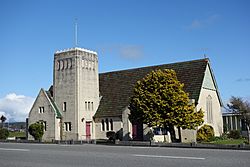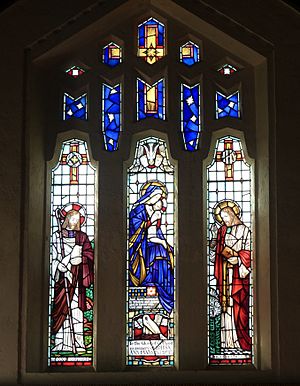All Saints' Church, Hokitika facts for kids
Quick facts for kids All Saints' Church |
|
|---|---|
| Hokitika Anglican Church | |

All Saints' Church, Hokitika
|
|
| 42°43′05″S 170°58′02″E / 42.71806°S 170.96722°E | |
| Location | 57 Bealey Street and Stafford Street, Hokitika, South Island |
| Country | New Zealand |
| Denomination | Anglican |
| History | |
| Status | Church |
| Dedication | World War I war memorial |
| Consecrated | 1 November 1936 by Bishop West-Watson |
| Architecture | |
| Functional status | Active |
| Architect(s) | Richard Strachan De Renzy Harman |
| Architectural type | Church |
| Groundbreaking | 1936 |
| Construction cost | NZ£4,142 |
| Specifications | |
| Capacity | 200 people |
| Materials | Reinforced concrete |
| Administration | |
| Parish | Ross and South Westland |
| Diocese | Christchurch |
| Province | Anglican Church in Aotearoa, New Zealand and Polynesia |
All Saints' Church, also known as Hokitika Anglican Church, is a special old church in Hokitika, New Zealand. It is an Anglican church, which is a type of Christian church. This building is very important, so it is listed as a Category I heritage building by Heritage New Zealand. This means it is one of the most important historic places in the country.
Contents
Why the Church Was Built
Early Church in Hokitika
When Hokitika was first settled during the West Coast Gold Rush in the 1860s, an Anglican church was built. This first church was made of wood and finished in 1866. It was located on Fitzherbert Street.
A Memorial for War Heroes
Later, the church members decided to build a new church. This new building would be a special memorial for the members of All Saints' who had died during World War I. They started raising money for the new church.
In 1919, an architect named Edmund Wilson was hired to design the church. He drew up many plans, but for various reasons, no church was built at that time. The agreement with Wilson ended in 1935.
Choosing a New Design
The church then asked other architects for ideas. They wanted the new church to be made of concrete and big enough for 200 people. It also needed to cost no more than NZ£4,000.
A design by Richard Strachan De Renzy Harman was chosen. The church members might have picked concrete because it was cheaper. Also, a nearby church, St Andrew's United Church, had been built with concrete in 1931. Safety from earthquakes, especially after the big 1931 Hawke's Bay earthquake, might also have been a reason to choose concrete.
Building the Church
Construction Begins
Building of All Saints' Church started in 1936. The church was officially opened and blessed on 1 November 1936. This day is known as All Saints' Day. The blessing was done by Bishop Campbell West-Watson, who was the Bishop of Christchurch.
Government Help
The government had a plan to help people find work during that time. This plan gave money to help build houses. In 1935, the plan was expanded to include churches, schools, and other buildings for non-profit groups. All Saints' Church was one of the few churches that received money from this plan.
The total cost to build the church was £4,142. The government paid ten percent of this cost.
Church Design and Features
The church has strong walls made of reinforced concrete. The roof timbers, floor joists, and flooring are made from rimu wood.
The font, which is a special basin used for baptisms, was carved from Oamaru stone. It was made by Frederick Gurnsey, who often worked with the architect Harman. Because concrete was used, Harman had to make the design simpler and more modern.
Original plans for the church included a roof made of cedar shingles and a tower with a spire. However, the church decided to use tiles for the roof instead. This change meant they could not have the spire.
The church also has a beautiful stained glass window. It was designed by an artist from Wellington named Frederick Vincent Ellis. This window remembers Louisa Ann Evans, who died in 1918. She was very important in helping soldiers during the war.
Heritage Importance
All Saints' Church is listed by Heritage New Zealand as a Category I building. Its registration number is 5012. This listing shows how important the church is as a landmark in Hokitika. The town does not have many tall buildings, so the church stands out.
The listing also praises the architect, Harman. It says he understood how to use reinforced concrete well. He believed that with concrete, it was best not to try and copy designs made for wood or stone. Instead, he created a unique and modern look for the church.
Notable Members of the Church
- Bess Hudson (1875–1961), a nurse who was a member of the church.


